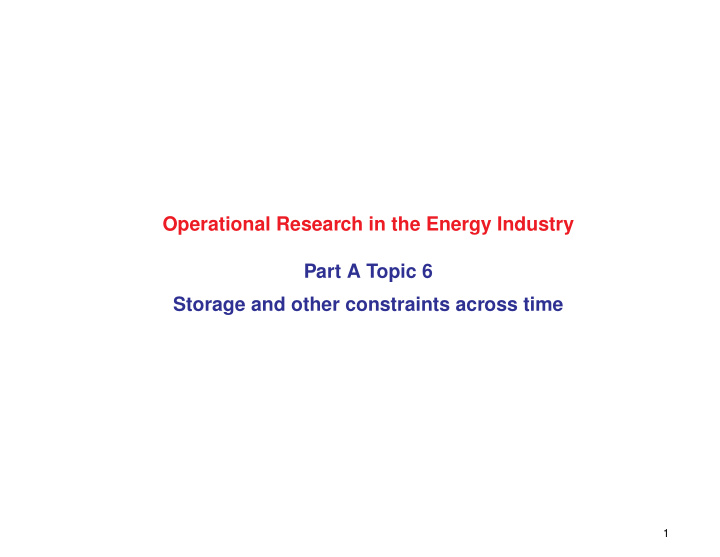



Operational Research in the Energy Industry Part A Topic 6 Storage and other constraints across time 1
Recall: Load Duration Curves Topic A 6: Storage Electricity demand varies a lot over the day and over the year. A Load Duration Curve shows load levels independently of when they occur. It is got by sorting all the individual (half hour) loads into descending order. GB Demand from 00:00 5/01/2015 to 00:00 11/01/2015 50000 Chronological Load Duration 45000 40000 MW 35000 30000 25000 20000 24 48 72 96 120 144 168 hours 2
Scheduling over Time Topic A 6: Storage Use of the load duration curve • simplifies the optimization problem • is often a good approximation • however it ignores the time sequence of loads and generation. The time sequence can matter because: • Generators cannot change their outputs instantaneously – they have Ramping limits . • Some generators cannot start up or shut down within a short time – the have Minimum up times and Minimum down times . • There may not be enough storage capacity to store generation to later times when it is needed. The growth of variable renewable generation makes these issues more acute. For these reasons we need to consider the sequencing of generation and storage. 3
Notation for Storage and Scheduling over Time Topic A 6: Storage We deal here with electricity storage only. Storage level is in terms of electric energy output. Sets: • T : Set of periods. Here T = { 1 , 2 ,..., T } • S : Set of stores Parameters: • P S+(-) : Maximum power into (out of) store s s • E S s : Storage efficiency: ratio of output to input energy for store s , Outputing 1 unit of energy reduces level by 1 unit. 1 unit of energy increases level by E S Inputing s units. • Q S+ s : Maximum level of store s • H S Hence Q S+ s = H S s P S- s : Number of hours of full output from store s when full. s • Q Ini s : Initial level of store s • C S s : Final cost per unit in store s after final period T . (Normally C S s < 0 ) Variables: • p S+(-) : Power into (out of) store s during period t st • q S st : Level of store s at start of period t 4
Storage and Scheduling over Time: Boundary conditions Topic A 6: Storage When scheduling generation over multiple periods, we need to know 1. The initial state of the system, e.g. the initial levels of the storage. 2. Information about the final state. This might be • A single final state, e.g. a target level for each store • A function defining how the future costs beyond the finite planning horizon depend of the final state, e.g. how does the future costs depend on storage levels. In the simplest case this could be a linear function of storage levels. In some cases there is a cyclic pattern of demand, and we would expect the operating policy to repeat every cycle. In this case we can find the best repeated operating policy by making the model cyclic as follows • Remove the initial conditions on the first period and the costs in the final period. • Make the first period follow the final period (i.e. as if it were period T + 1 ) 5
Rolling Horizon Planning Topic A 6: Storage • Investment and operational planning usually happens over an indefinite horizon and the data becomes increasing uncertain further into the future. • Since we can only plan over finite time horizons, a common approach is to plan sequen- tially over overlapping intervals, but only implement the first part of each plan • At the end of the interval we need to give a value to the final state, e.g. the future value of the water left in a reservoir • The hope is that by the end of the planning interval the uncertainty in the future value has a small effect on the decisions in the initial part that is implemented. Level Plan Level Future Cost Implement Plan Start Level Level Future Cost Implement Plan Start Level Future Cost Implement Start Level 6
Tasks Topic A 6: Storage Tasks: • Extend the formulation to include storage Assignments 3 and 4 will involve the cyclic model of storage and the time sequence of gen- eration. 7
Recommend
More recommend